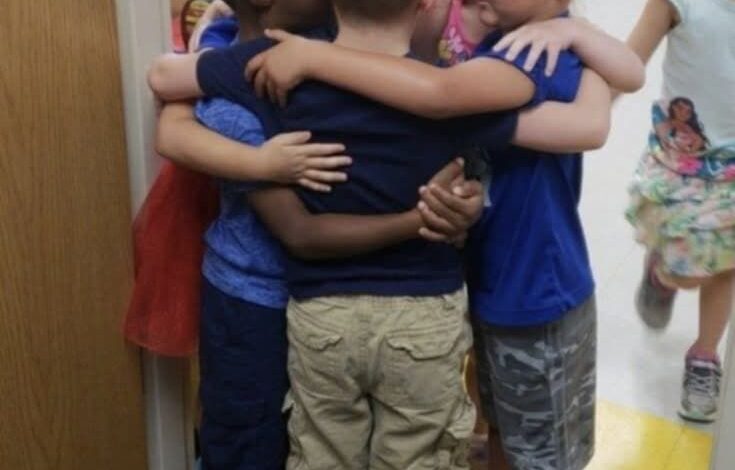Kindergarten Children Form Spontaneous Prayer Circle – No Adult Guidance Needed

Medical Recovery and the Joy of Answered Prayers
Lunchtime brought wonderful news: Nadine called to report that Janelle’s mother was improving and would likely be discharged that evening. Sharing this update with the children resulted in pure joy, with Izzy exclaiming, “That’s because we prayed, right?”
Rather than dismissing their faith-based interpretation, I acknowledged their caring hearts: “Maybe your kindness helped in ways we don’t fully understand.” This response validated their compassion while maintaining appropriate boundaries in our educational setting.
The Beautiful Return and Expansion of Compassionate Community
Several days later, Janelle burst through our classroom door with unprecedented energy, announcing, “Mommy’s home, and she’s okay!” Her joy was infectious, immediately drawing her three prayer partners into another grateful circle.
This time, their whispered words carried thanksgiving: “Thank you, thank you, thank you.” Whether addressing God, the universe, or simply expressing gratitude, their sincerity was unmistakable.
During our conversation about her mother’s recovery, Janelle shared important health information she’d learned: her mother needed proper hydration and rest, and doctors had provided medical treatment for her dizziness. With childhood simplicity, she concluded, “We prayed for her, and she’s better now.”
Her next concern revealed mature emotional intelligence: “I hope Mommy doesn’t have to work so hard anymore so she doesn’t get sick again.” This worry about parental stress and work-life balance showed remarkable awareness for such a young child.
Understanding the Root Cause: Single Parent Challenges and Health
Meeting Janelle’s mother during pickup provided important context. She appeared healthier but tired, explaining her situation with evident embarrassment: “I’ve been working two jobs, and it finally caught up with me. I passed out on my lunch break.”
Her experience highlights common challenges facing single parents: financial pressure leading to overwork, inadequate self-care, and the resulting health consequences. Her gratitude for community support during the crisis was deeply moving.
The Growing Circle: When Compassion Becomes Contagious
Two weeks later, I discovered their prayer circle had expanded significantly. More children had joined the original four, creating a larger community of care and support. Their whispered petitions now included various family concerns: grandparents’ health, parents’ employment situations, and even lost pets.
Rather than discouraging this behavior, I recognized its value in developing empathy, community connection, and emotional support systems among young learners. These children were naturally creating positive peer relationships and practicing compassionate leadership.
Educational Insights: What Adults Can Learn from Children’s Natural Compassion
This experience taught me profound lessons about childhood development, emotional intelligence, and the innate human capacity for empathy. These young students demonstrated that caring for others requires no formal instruction—it emerges naturally from open hearts and genuine concern.
Their approach was beautifully simple: identify a problem, gather supportive friends, and take action through prayer and hope. No adult guidance was needed; they instinctively understood the power of community support during difficult times.
The Broader Impact: Building Character Through Shared Experiences
This classroom experience highlights several important aspects of child development and educational psychology:
Emotional Intelligence Development: Children naturally recognize emotional distress in peers and respond with appropriate support mechanisms.
Community Building: Young learners can create meaningful support networks without adult intervention, fostering positive classroom culture.
Spiritual Development: Children’s natural spiritual curiosity and faith expressions contribute to their overall emotional well-being and coping mechanisms.
Crisis Response: When faced with concerning situations, children often turn to hope-based activities and mutual support as healthy coping strategies.
Conclusion: The Transformative Power of Childhood Faith and Community
This remarkable experience reminds us that compassion, hope, and community support are fundamental human characteristics that emerge naturally in childhood. These four-year-olds created something beautiful through their spontaneous prayer circle—a support system built on genuine care and shared faith.
Whether we call it prayer, positive energy, or simply caring for one another, the result remains the same: people coming together to support those in need. Perhaps we could all learn from these kindergarten students who clasped hands and whispered their hopes without fear, shame, or need for instruction.
Their story serves as a powerful reminder that in our complex adult world, sometimes the most profound wisdom comes from the simplest hearts. The willingness to hope, to care, and to take action—even in small ways—can make a meaningful difference in someone’s life.
About This Story: This account highlights the natural development of empathy and community support in early childhood education settings, demonstrating how children’s innate compassion can create positive classroom environments and meaningful peer relationships during times of family crisis.
If this story touched your heart, consider sharing it with others who might benefit from this reminder about the power of compassion and community support. Sometimes the most important lessons come from our youngest teachers.